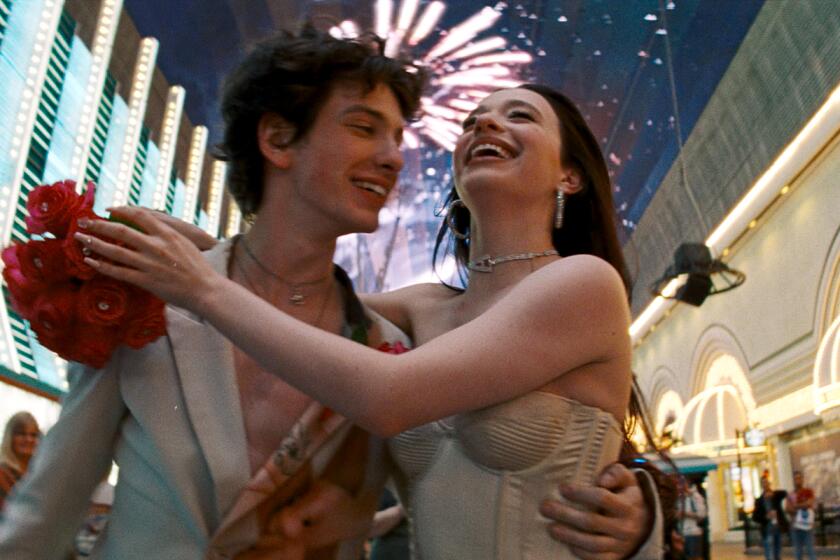A Little Shut-Eye
- Share via
The American Cinematheque’s “Alternative Screen” presents Peter Calvin’s challenging experimental feature “Sleep,” which combines documentary and drama in exploring the phenomenon of sleep and its myriad disorders. Calvin’s film is witty and elegant looking, but his fragmented approach, bordering on the surreal, is likely to daunt all but the most dedicated admirers of experimental films. “Sleep” screens at 7:30 tonight at the Lloyd E. Rigler Theatre at the Egyptian (6712 Hollywood Blvd., Hollywood). (323) 461-2020.
One of “Alternative Screen’s” liveliest offerings, Carrie Ansell’s inspired and outrageous debut feature, “Flushed,” which screened at the Egyptian in April, returns as part of the Laemmle Theaters’ “Summer Series.” In addition to the series’ regular Saturday and Sunday 10 a.m. screenings at the Sunset 5 (8000 Sunset Blvd., West Hollywood), it will also screen there Friday and Saturday at midnight. It will then screen Aug. 21 and 22 at 11 a.m. at the Monica 4-Plex (1332 2nd St., Santa Monica).
“Flushed” is a classic example of a filmmaker hitting upon a simple, potent idea and running with it. “Flushed” takes place entirely within the restrooms in a downtown Gen X-er New York club on a very busy night; it is so cleverly sustained it could almost be mistaken for a documentary.
This 81-minute no-budgeter is a real test for a first-time filmmaker in several aspects. You know that such a film is going to be steeped in blunt talk about genitalia, bodily functions and sex, and Ansell manages to vary sufficiently the things men and women will say and do when they’re among their own sex to sustain interest and invite affectionate rather than derisive laughter.
She manages to find humor in the vanities, vulnerabilities and quirks of about 100 different individuals. This is no small achievement at a time when bathroom scenes are so often tasteless and when many people feel uncomfortable with a great deal of what is discussed in this picture. Ansell has the kind of easy, liberating, compassionate humor that invites you to laugh at yourself. Sunset 5: (323) 848-3500; Monica 4-Plex: (310) 394-9741.
The UCLA Film Archive’s “The Stuff That Dreams Are Made Of: The Films of Marcello Mastroianni” continues Friday at 7:30 p.m. at Melnitz Hall with Marco Bellochio’s exquisite 1984 film of Luigi Pirandello’s “Henry IV,” in which Mastroianni plays a nobleman, thrown from a horse in his youth, who awakens believing he is the Holy Roman Emperor. One day the nobleman’s nephew (Gianfelice Imparato) enlists a group of people to make one last attempt to restore him to sanity. In the party is a beautiful marchesa (Claudia Cardinale) from the noblemen’s past; she may hold the key to his cure. “Henry IV” has a rich, shadowy look and a romantic quality heightened by Astor Piazzola’s lush score. It is marked by superb ensemble playing but is rightly dominated by Mastroianni, whose resources as an actor seem limitless. It will be followed by a rarity, “Scipio the African” (1971), a send-up of the Roman Empire in which Mastroianni teamed with his real-life brother Ruggero, a noted film editor who had always wanted to take a fling at acting.
Federico Fellini’s “Ginger and Fred” (1986) pairs Mastroianni with Giulietta Masina as one-time music hall stars, a dance team emulating Astaire and Rogers, who are reunited for a TV variety show, which allows Fellini to take aim at the mindlessness of television. Never mind this overly familiar target or that Fellini threatens to succumb to the very excesses he means to skewer, for as “Ginger,” who has become a hard-working businesswoman, and as “Fred,” a boozy, wheezy, outrageous old rebel, seedy yet ineffably debonair, Masina and Mastroianni offer a lesson in expressiveness as they toss off a look, a shrug, a gesture, each of them perfect--and all adding up to a gracious acceptance of mortality. It will be followed by Nikita Mikhalkov’s superb “Dark Eyes” (1987), in which the famed Russian director found in Mastroianni an ideal interpreter of a Chekhovian idler. Sunday brings (at 7 p.m.) the Fellini classic “8 1/2” (1963), in which Mastroianni serves as the filmmaker’s alter ego, as a film director, on location and in the throes of a creative crisis.
Note: William Wellman’s gangster classic “The Public Enemy” (1931), starring James Cagney, is tonight’s “Archive Treasure” presentation, accompanied by a program of short subjects of the same vintage. It will also screen in Melnitz Hall. (310) 466-FILM.
*
The American Cinematheque’s “Fantastic Voyage: A Tribute to Richard Fleischer In-Person,” a long overdue honor to one of Hollywood’s least pretentious and most underrated professionals, commences Wednesday at the Egyptian at 8 p.m. with a screening of “The Boston Strangler” (1968), a taut and incisive thriller, stylishly incorporating a multi-image technique and a stream-of-conscious narrative. It was an inspired collaboration by Fleischer, screenwriter Edward Anhalt and Tony Curtis, in one of his best serious performances, as tormented serial killer Albert DeSalvo, who terrorized Boston in the early ‘60s. Henry Fonda is the chief of detectives determined to catch the killer. Watching Curtis enact DeSalvo’s key moment of disintegration on a set at Fox was an unforgettable experience, and its power comes through on the screen. Curtis will appear with Fleischer at the screening. (323) 466-FILM.
*
Also beginning on Wednesday. the UCLA Film and Television Archive hosts “Visible Evidence VII,” an academic conference and public film series on the role of the documentary. Opening a program of documentary shorts is Tran T. Kim-Trang’s 23-minute “Ekleipsis,” which delves into the so-called “hysterical” blindness afflicting Cambodian women, refugees from the Khmer Rouge genocide, now living in Long Beach. Another offering in the opening-night program is William E. Jones’ 20-minute “The Fall of Communism as Seen in Gay Pornography,” which calls attention to the plethora of erotic videos produced with Western money mainly in Budapest, Prague and Moscow since 1993. We learn that many impoverished young men are responding to the opportunity to make some quick money--but are paid only a fraction of what their American counterparts earn. Jones’ film, which includes no hard-core footage, does not tell us if these videos are sold in the countries in which they are made or whether their participants adhere to the safe-sex guidelines upheld by the U.S. porn industry establishment.
In Marina Goldovskya’s 58-minute “A House on Arabat Street” (1993), which will be presented Thursday at 7:30 p.m., along with excerpts from other Goldovskya works, the turbulent history of 20th century Russia unfolds in the story of a splendid turn-of-the-century apartment house. A handsome Beaux Arts pile of restrained Gothic design featuring at street level niches containing statues of knights, the 80-unit apartment house originally was home to some 200 people; by 1930 that number, via communal living edicts, had risen to an incredible 3,000. The people we meet are mainly those in their 80s and 90s, survivors of the Russian Revolution and all that followed. In its loving way, the film is a tribute to the enduring Russian soul. (310) 206-8013.
Jennifer Baichwal’s intriguing “Let It Come Down: The Life of Paul Bowles” is a splendid, provocative introduction to the legendary American expatriate writer and composer, who has lived in Tangier for more than 50 years. Baichwal started filming just in time, for such close friends of Bowles as David Herbert, Allen Ginsberg and William Burroughs--the latter two seen with Bowles in 1995 during his first visit to New York in 35 years--have since died. Baichwal allows Bowles et al to contradict each other freely, and through this largely amiable give-and-take we get an impression of Bowles as determinedly individualistic as he is reticent, the second quality reflective of his austere New England upbringing. Both as a writer and as a composer, although he has given up music, Bowles’ stature grows along with the mystique that has grown around him and his late, tormented wife, acclaimed writer Jane Bowles, as being central figures in Tangier’s expatriate community, a refuge for gay artists and intellectuals. Baichwal allows for some pointed rather than judgmental commentary on this community’s privileged status before Moroccan independence and its detachment from the country’s social issues. Born in 1910 and 87 when he was filmed, Bowles, who incidentally loathed the film Bertolucci made of his novel “The Sheltering Sky,” comes across as a witty, wise patrician who has the courage of his convictions. The documentary screens at the Nuart (11272 Santa Monica Blvd., West L.A.) Saturdays and Sundays at 11 a.m. through Aug. 22. (310) 478-6379.
*
“Hitchcock by Hitchcock: A Centennial Salute,” a complete retrospective of the 20 movies for television the master of suspense directed from 1955 to 1962, along with rarely seen interviews and a documentary, will screen Friday through Sept. 12 at the Museum of Television & Radio (465 N. Beverly Drive, Beverly Hills). (310) 786-1000.
The seventh annual Long Beach Gay & Lesbian Film Festival runs Friday through Sunday at the Carpenter Performing Arts Center at Cal State Long Beach, 6200 Atherton St. Tickets: (562) 985-7000; for further information contact the center, (562) 434-4455.
More to Read
Only good movies
Get the Indie Focus newsletter, Mark Olsen's weekly guide to the world of cinema.
You may occasionally receive promotional content from the Los Angeles Times.







